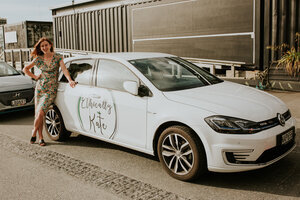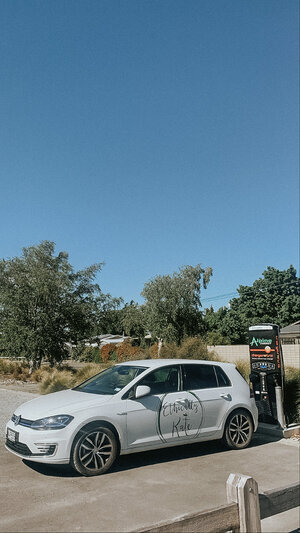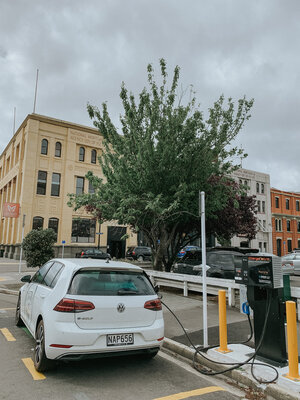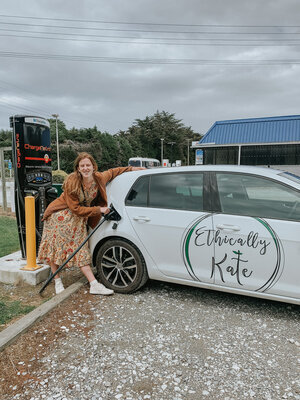What I Learnt Driving A 100% Electric Vehicle Around Aotearoa New Zealand
Main image by Moustache Media
I’ve never bought a car and I’ve never understood car people. Hand-me-downs that simply get me from a to b, public transport, biking, and my long legs are what I’ve used to get around. But recently I drove around Aotearoa New Zealand for 5 weeks in a Volkswagen e-Golf on tour. It ruined my life; I don’t think I can ever go back to a petrol-run vehicle.
I now understand what ‘car people’ are on about when they lust over vehicles, and I have respect rather than confusion for my neighbours who lovingly clean their car every weekend.
The Volkswagen e-Golf was exceptional. Not only did it reach all my expectations, it smashed through them and blasted into another dimension that means every time I look at the car, the corners of my mouth turn into a smile.
Images above by Nectar Photography
After driving 5000+ KMs in this beautiful creature, temporarily joining the electric vehicle club (an honour), and receiving weekly questions, I’ve learnt a thing or two about electric vehicles. I’ve also noticed the fake news and rumours that fill the electric vehicle conversation, and while I am definitely no expert, I’ve done a bit of research.
Here’s what I learnt while driving a 100% electric vehicle around Aotearoa New Zealand.
Note: Volkswagen gave me the e-Golf to borrow for the duration of my tour. While this blog post was produced in return for their generosity, it’s 100% my own words and opinions.
My first house charge! Hamilton.
When comparing the environmental impact of an EV to a petrol-run vehicle, it depends on SO many things.
“Does the environmental cost of the battery and vehicle production outweigh the environmental benefits of running on electricity?” This question was asked more times that I could count. While it’s encouraging to hear so many people dig deeper and not simply accept EVs as 100% sustainable, there is a lot of confusion when it comes to their environmental impact.
During my tour, I was faced with “oh but electric vehicles are worse for the planet, didn’t you know that?” and when I replied “where did you get that information from?” I found out it was usually from a chat at a bar with someone who heard it from a juicy news headline, or from someone who really wanted an electric vehicle and was jealous of their EV driving friend.
There is certainly environmental damage caused by EVs, but my view is this:
EVs are not the end solution to sustainable transport, but they’re an excellent step in the right direction.
Let’s start with the production of the car. Of course, every new car has an environmental impact. Every single part of the car is made from some sort of resource and resources are often finite. Some parts will be sourced from recycled and recyclable materials, but others will be virgin materials that may disturb ecosystems in areas where the material is produced. A particular concern for EVs is the production of the batteries. EV batteries contain some scarce minerals, like cobalt and lithium, which can only be found in particular countries. Especially as demand for EVs grows, there is valid concern around the worker wellbeing and regulations in these countries.
A recent report by UNCTAD suggested that we need to be putting our energy into the improvement of ethical mining practices and the recycling of the minerals in batteries. If done well, they predict new and beneficial business and employment opportunities. Creating batteries out of less precious and more common materials will not only mean the environment is less pillaged, but the cost of replacing a battery (currently a barrier for many people) will also go down.
To add to the benefits of driving an EV, a conventional car generally has around 2,300 moving parts and an EV has 100. Imagine no oil changes, less part replacements, lower costs for the EV owner, and lower cost on the environment. With a few battery changes over its lifetime, an EV could last for up to 1 million KMs, whereas a conventional vehicle may last around 300,000.
Regardless of if an EV is produced sustainably or not, the ongoing environmental impact of an EV also comes down to how the electricity it runs off is being produced. Here in Aotearoa New Zealand, approximately 83% of our energy comes from renewable sources. But if your energy is powered by fossil fuels, an EV can have a similar environmental impact to a conventional petrol-run car. Thankfully, as most countries decarbonise their electricity generation to meet climate targets, EVs start to make more sense.
Electric vehicle battery conversations could last for days.
Back to the battery, the battery, the battery. Most people are clued up on the fact that batteries can be an environmental issue. Sometimes I wouldn’t even get to sit down after a long driving day, before my host (friends and family) would ask “but what about the battery?”
The life of a battery varies greatly, but on average it’s expected to be around 10 years. When a battery is no longer fit for use in an EV, it can be recycled or repurposed. Supermarket chillers, farm generators, forklifts, street lighting, and even EV charging stations are reuses that are already implemented around the world or in the trial process.
In the recycling process, the individual battery parts are first shredded, then the material is dried and sieved. This allows for the valuable raw materials of nickel, manganese, cobalt and lithium to be extracted.
These materials are then separated individually, and are immediately available again for the production of new batteries.
Speaking on behalf of Volkswagen, they aim to recycle 97% of all raw materials in the battery packs. Today it’s roughly 53%, and the plant in Salzgitter expects to raise this to around 72% soon. Volkswagen’s aim is to handle battery recycling internally. This is a priority for cost and environmental reasons, especially with the amount of EVs they plan on selling. Battery shredders won’t be busy until at least another decade, but Volkswagen are incredibly aware of their responsibility to ensure the batteries are either recycled or reused.
To summarise an incredibly complex and ongoing discussion, comparisons between the environmental and social impact of electric vehicles and petrol-run cars are complicated. Factors that contribute to the conversation include the weather in the country you are driving the car, the size of the car, the factory where each part is produced, how the car is driven, what recycling opportunities are available locally to you, the demand for repurposed batteries in your area, and the colour of the lipstick the driver wears (I’m kidding about the last one).
Venturing through the Port Hills, Christchurch. Image by Moustache Media
When you drive an electric vehicle, the first question everyone asks is ‘what’s the range'?’
If you’re an EV driver, the length of your range determines your social status. I felt quite elite when I could answer ‘220km’. EVs currently range from 100 - 1000kms, but when you get past 200-300km range, you definitely pay for it.
Charging is easy and becoming more accessible every single day.
I won’t lie, driving an EV was probably the main thing I was nervous about when planning the tour. Talking to a crowded room of people; easy. But the thought of being stranded in the middle of nowhere with a flat battery or turning up late (or not at all!) to one of my events, made me petrified.
After driving the e-Golf for just half a day, those nerves went out the window. I took quickly to the new routine of using the ChargeNet (and sometimes PlugShare) app to plan my route each day, and I was always warmly welcomed when I let my friends know I’d be rocking up to their place in an EV and would like to charge overnight.
Before you read the below, remember that the e-Golf has a range of approximately 220kms. This differs depending on how much you use the air conditioning and how many hills there are. The EV uses more energy as it goes up hills, but it charges as you brake. One day I travelled for 40 minutes and arrived at my destination with MORE charge!
All You Need To Know About Charging An EV
First things first; the cost. The cost depends on where you charge, but it is always cheaper than petrol. At fast charging points like ChargeNet, the cost is approximately 30c a ‘litre’ compared to $2.16 for petrol. Fast Charging data from ChargeNet NZ shows an average fast charging session costs customers less than $7, meanwhile ChargeNet already has 200 charging stations across the country - on average, one new station pops up every week! Charging at home is cheaper and even cheaper again when the charge happens during off-peak hours. Some EV users who don’t travel far don’t use fast charging stations regularly or at all.
There are two ways to charge up an EV. At home (for an e-Golf this takes approximately 20 hours from flat to full), or at a fast charging station. I charged 39 times at fast charging stations and 4 times at homes during my 5 week long trip. I am a cautious EV driver, so some of those charging sessions were only 10-15 minutes while I went to the bathroom or grabbed a cuppa. Charging when you can rather than when you need is always best practice especially on road trips, but I think I was still too cautious. I could have charged around 25-30 times. The longest amount of time I spent at a fast charger was 57 minutes. On average, each charge was 30 minutes. On my long travel days, I would charge up around 3-4 times.
Most charging stations I visited were in the parking lots of New Worlds, or opposite petrol stations. This was great as I could top up on supplies and use the bathroom. It was frustrating when the charging station wasn’t walking distance to ammenities, but I’m certain that as the demand for EVs grows, the more each station will be developed.
Unlike a petrol station, there are usually just two car parks in front of charger. Fortunately, I only had to wait around 2-3 times at a charger for someone to finish!
You can find more information about what I learnt about charging etiquette here.
The e-Golf is superior to a Nissan Leaf.
When visiting my grandparents in Christchurch, I borrowed their 2011 Nissan Leaf for two days to visit a friend. My parents also own a similarly aged Nissan Leaf, and they’re one of the most common EVs you see on the road. Even though they’re popular, I couldn’t have done a trip like this in the Leaf - unless I was prepared to charge at random campsites and spend most of my time charging! The range is nearly double, the comfort is incomparable, the features are way more road-trip friendly, and the centre of gravity feels lower - making for a more comfortable journey. I now understand the benefits of investing in a car with longer range and newer technology.
Road tripping in an EV pushes you to be present.
Instead of stopping at the main touristy spots around the country, I was forced to explore the surroundings of charging stations. What an incredible way to see more of the country! I wandered through gardens and museums I never knew existed, and when I felt the rush to ‘get there’ even when I knew I didn’t have a deadline, the process of charging the car helped me slow down and live in the moment.
The e-Golf is more clever than me.
I swear the e-Golf has a higher IQ than me. It’s following distances while on cruise control are generous and safe, the auto function for lights and windscreen wipers is always one step ahead of me, and the way it locks and opens without me having to search for the keys makes me feel special.
After driving 5000+ KMs, I expected to feel sore and want to avoid getting in a car for a while. But it’s the opposite! The comfort of the e-Golf is ideal for long trips, and saves your body from usual road tripping aches and pains.
Stopping to check out the view on my way from Wanaka to Queenstown
Not only am I grateful for Volkswagen’s generousity of lending me a car for 5 weeks, but I’m also stoked to hear they are working on their sustainability in a big way come 2021. I’m excited!
To summarise a massive 5 weeks of learning…
EVs are reducing dependancy on fossil fuels and pushing the world to innovate. As the demand for EVs grows, so does the time and resources spent on making EVs more affordable and sustainable.
I was incredibly impressed with the e-Golf.
Road tripping with an EV is a more enjoyable experience.
There are enough charging points around the country to avoid ‘range anxiety’.
Charge when you can not when you want.
I highly recommend that anyone looking to purchase a vehicle, considers electric. Not only that, but they continue talking to friends, colleagues, and family about the issues I mentioned above, and be part of the movement towards sustainable transport.
Stopped for a swim on the east coast











